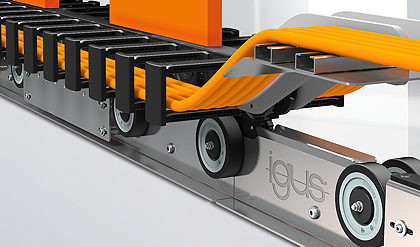- Home » News » Technology News
First motor-driven energy-chain can travel more than 1km

Igus claims to have produced the world’s first driven energy chain, almost eliminating limits on travel distances, which can stretch to well over 1km. The technology also delivers high dynamics and long running times because there are hardly any push/pull forces acting on the chain.
Igus expects the driven e-chain to be particularly attractive for applications such as rail-mounted automated stacking cranes (ASCs) used in ports around the world, where it could save several tonnes in weight compared to alternative technologies such as the drums that are currently used to wind and unwind motor cables.
The new chain uses drive boards that are mounted on the outer radius of the e-chain and drive it in the lower run. The bottom rail has motor-driven friction wheels on the sides, and rollers on the top. When the chain starts to move, the friction wheels also start their motors. The lower run travels along the rail in a synchronised movement, with hardly any push/pull forces acting on the chain links from the moving end.
“This gives us a minimal load, low wear and long service life on travels of 1,000 metres and more”, explains Jörg Ottersbach, head of igus’ e-chains business. igus is also working on an alternative concept that uses linear drives instead of the friction wheels.
The huge size of modern container ships poses problems for ports authorities which have had to expand their infrastructure continuously to keep pace – including the stacking cranes that load containers onto lorries and trains. Forty years ago, each container ship carried around 1,000 containers. Today, the largest vessels can carry almost 24,000 containers. To cope with this, the huge overhead cranes now need to travel on rails for distances of several hundred metres or more. In many cases, the motor cables have to follow the movement of the cranes.
Traditionally, this issue has been dealt with using steel cable drums that wind and unwind the motor cables – often in two directions when the fixed point of the cable is in the middle of the travel. However, when the crane approaches this fixed point, it has to brake to allow the cable guidance system to pivot. This takes time, which is a problem for ports that are continuously trying to boost their productivity. Also, each motor drum weighs 4-6 tonnes, adding considerably to the cranes’ energy consumption.

igus believes that its self-powered energy supply system offers an economical alternative to the drum systems. “At lengths of over 1,000 metres, enormous push/pull forces act on the e-chains”, Ottersbach points out. “To prevent this load and further optimise energy supply system service life in extreme applications, we are the first developer in the world to develop an energy chain with its own drive.” It can accelerate at rates of 5-6 m/s2, even on long paths.
“Since the drive-chain travels on the rail without interruption, ASCs no longer need to brake near the fixed point in the middle,” Ottersbach adds. “They can thus work more productively.
“At the same time, the e-chain system increases neither the overall weight nor the system drive power required to move it,” he adds. “The lower weight allows speeds of 6m/s even on long travels. These are significant advantages, benefiting more and more port operators around the world.”
igus: Twitter





